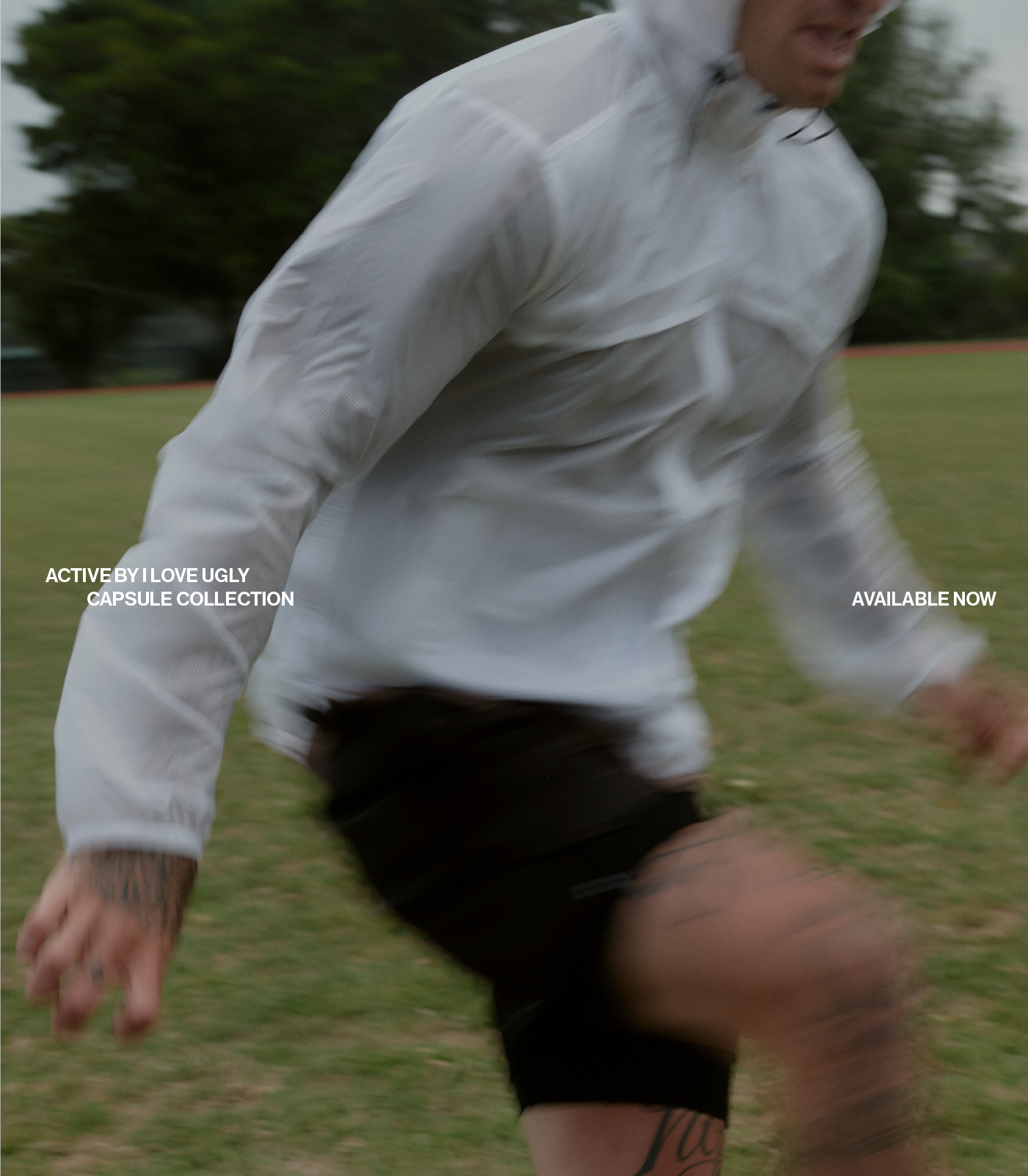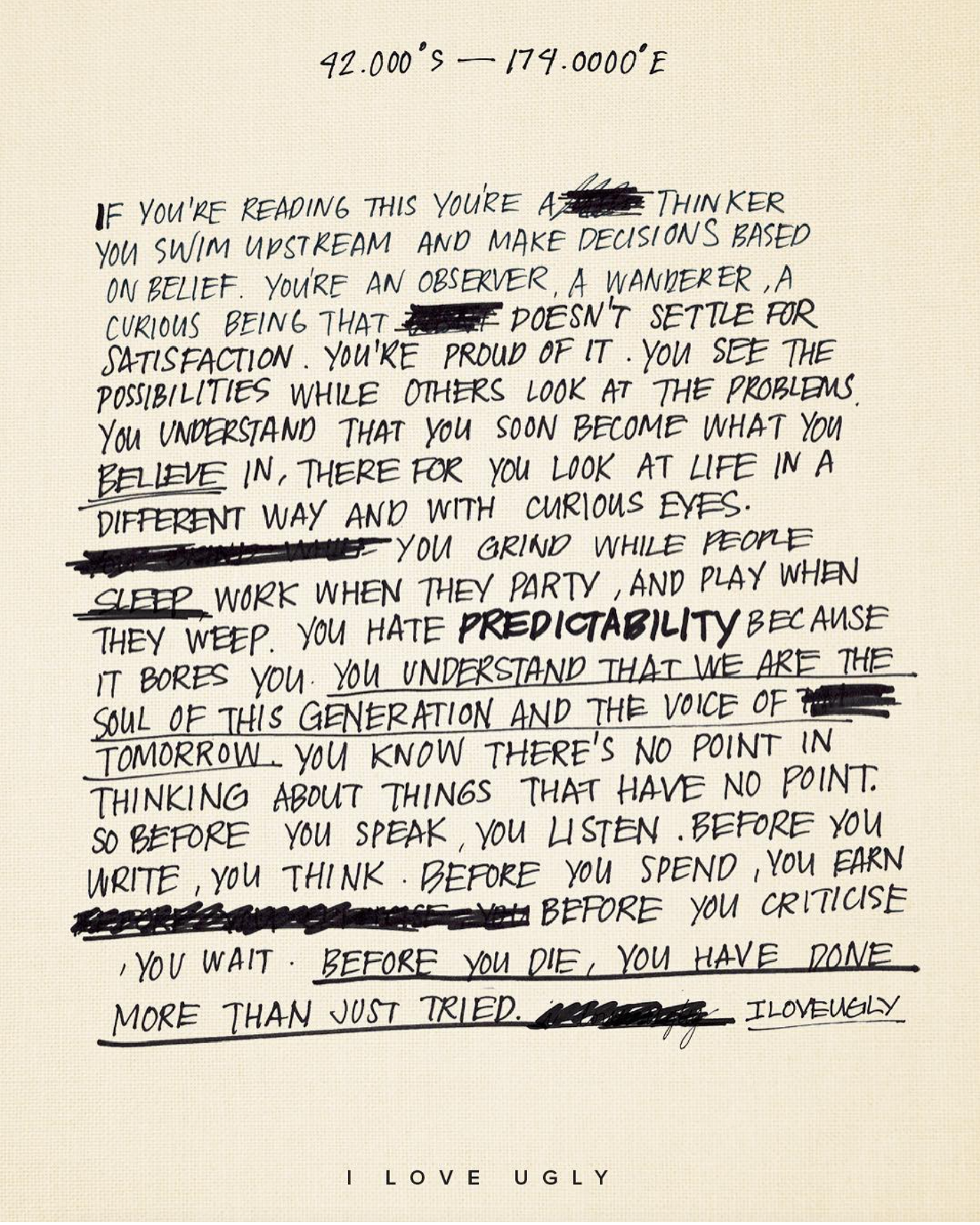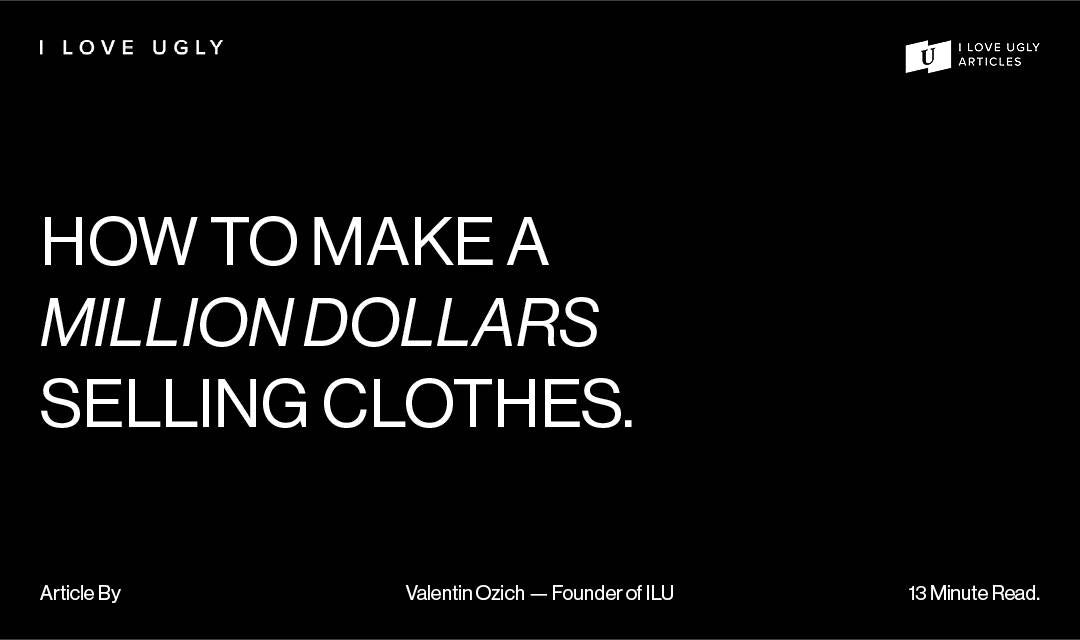Overview
I wish someone had written this article when I began, instead my how-to guide was the school of hard knocks. Don’t get me wrong there will be other successful people that read this and disagree with a few points, but I wanted to give you my version of it. This guide doesn’t make it easier, but it will save you time and help you avoid making the same mistakes I made.
This is complete unfiltered honest process that I have personally learnt the hard way. The worst thing you can do is go into fashion thinking it's easy and a quick way to make some money like a lot of people do. From the outside, it looks like the easiest and most fun business you can be in, but in reality, it’s very complicated. There are a lot of moving parts that need to be taken care of, otherwise everything else falls apart.
I want to give you an honest insight into where we’ve come from, and to show you we’re still learning. Hopefully this can help create a successful juggernaut brand for somebody out there. If that happens to be you, just buy me lunch one day.
- Valentin
Founder & Creative Director
I Love Ugly
1. Figure Out Your Why
Before you dive in, you need to really do some deep digging and figure out exactly why you are doing it. If it’s just about making some easy money, that’s a stupid reason and it’s going to kill your business quicker than your warehouse burning down. Of course it needs to make money in order to survive, but if it’s only about the money you will end up making short-term focused decisions to chase your shortsighted goal. I have seen this happen time and time again and most of these brands don’t last more than a few years and end up losing a lot of money in the process.
In my case I had a few reasons to start. The first was, I couldn’t find a graphic design job as it was right in the middle of the global financial crisis and the economy was bad, therefore not many people were hiring, and especially not university graduates with no experience. I wanted to do something that I could apply my graphic design and illustration skills to, while feeding my wife and daughter at the same time.
Secondly, I saw a gap in the market for classic menswear, with a contemporary twist, that catered to 18 - 30 year olds at a fair price and sold online. (Remember this was in 2008). This small window of opportunity made me pounce on it quickly because I had a strong why. Today, my why is different, but it’s important to always have one, especially when you start out as that will give you the emotional conviction you need during the turbulent times.
2. Mindset.
I know I go on about this, but I can’t stress enough how important it is. 20% of the success of your brand is going to come from the uniqueness of your product, service and business acumen and the other 80% from your psychology. If only I knew this when I started and if only people talked about this more.
What I mean by this is you’re going to get stressed. You’re going to feel lost sometimes. You’re going to get frustrated. You’re going to lose money and sleep. People are going to disappoint you, laugh at you and talk behind your back. Factories are going to make mistakes, but you need to know in business and in life, that this is normal. You need to learn to anticipate that these things are going to happen rather than react and let them defeat you. I'm not saying these things to discourage you, I’m saying these things to make you stronger, and increase your chances of success by becoming more aware.
When most people encounter these problems, they quit. Why? Because it's easier and it’s the sane thing to do. However, an entrepreneur pursuing his or her dreams isn’t the norm. They see the world differently and don’t opt into a cookie-cutter existence. Embrace these qualities, as it’s a very special trait. When you do encounter problems, which you will, I hope this point helps you to see the situation in a different light.
Fashion is grueling, cutthroat and hard. You have to really be prepared to be involved in all the ins and outs of running a business and develop the skills you probably don’t have and don’t come naturally.
So be prepared to become a student of self education again. If you just want to be creative, maybe become a painter.
The industry works on cycles - and they don't end - ever. You will always be smack in the middle of 4-8 cycles at any given time and they all require different thinking and strategies. Generally one cycle is 9 months, 3 months of design and sampling, 4 months of production and shipping and 2 months of marketing the range once its out. At any given time you will have four - six ranges going and they’ll all be at different stages. Designing one, sampling or delivering another, all while you are working hard to market the product that is currently in store.
Fashion is about creativity but it’s also about business, it takes real tenacity to make it all work and get product delivered to stores and customers.
3. Create a marketing strategy.
Ask yourself these key questions: Who are you going to be targeting? What makes your stuff better or different to everybody else? Why is your brand needed in the market? This isn't something they touch on in fashion school, which I find fuckin stupid.
What will you focus on that is special and unique? How are you going to promote your products to your customers in a way they haven’t seen it before? How are you even going to get a customer without copying your main sources of influence?
Are you going to price high or low? And why? What is going to be your route to market (retail, online or wholesale? - maybe a mix of all three, if so - when and how?) Remember, best known will unfortunately always beat the best product. Look at McDonalds for example, crappy food, but everybody knows about it.
You need to become a marketing specialist or find someone that is, and simply posting your product on Instagram everyday isn’t marketing.
4. Identify a Niche.
Most fashion brands have a speciality or a flagship product that really defines them, whether it be the Supreme box logo tee or a handbag for Louis Vuitton. There is a reason why these products have been so successful - it’s because they were different and resonated with a customer base in a way they hadn’t seen before.
Ask yourself this question - do I already have the ability to buy the product I am creating? If the answer is yes - then why are you making it? It’s probably time to go back to the drawing board homie. If the answer is no - maybe you are on to something, or maybe there is a reason no one else makes that product.
You see what we mean about fashion being tough.
5. Drive, determination and dedication.
We are not kidding here. If you’re going into this half-hearted, you're already dead before you’ve started. You need to become relentless and learn to cancel out the naysayers unless they are customers. That’s who you should really be listening to, especially if they are saying it’s wack or worst; they wouldn’t wear it.
This is another reminder to focus on building your mindset throughout the process, it’s going to be tough, you’ll want to quit, but remember if it was easy, everyone would be succeeding in it.
6. Cross your T’s and dot your I’s.
Register your trademark in the country you will be manufacturing as well as the countries you will be selling in. We fucked this up, and it isn’t pretty. You can never do this too early, but it is an expensive process so make sure you budget for it. Don’t worry legal fees are a lot worse.
7. Define Your Brand Principles.
Who is going to talk about you and why? What will people say about your brand behind closed doors? What are people going to remember you for? Why should anyone care? What does the brand stand for? Who are you?
Make sure your whole team is on the same page with these ideals as one weak link in this chain can cause a breakdown of communication and flow of ideas. Having the ability to convey a consistent brand message throughout all touch points of your company is super important.
An exercise I like to do is figure out what the lounge or room of your brand would look like. The type of art on the wall, the food it would serve, the furniture etc.
Then do it for who the person is that’s sitting in that room. What’s their personality like? What are their likes and dislikes. What do they look like and dress like?
This activates the creative part of your brain and is really good exercise to carve out the layers of your brand and a strong visual identity.
8. Come Up With a Name
Something that is catchy, interesting and maybe a little bit crazy. Do you want it to sound like others or do you want people to remember it?
Also make sure it’s trademarkable.
9. Find a supplier.
To be honest - a good starting point is Google (simply google ‘clothing manufacturer), Alibaba or a friend in the fashion industry that might be able to point you in the right direction. Lots of brands can be quite protective over their suppliers and rightly so. This might be a quite hard step and take some time, but be persistent and you’ll begin to figure it out.
Travelling to where you want to produce your products first off is definitely worth the investment and if you can afford it. If that is going to be in Asia - go to Asia and talk to some people. If it’s going to be in the US, travel to meet the suppliers there. Remember working via email isn’t ideal. People will treat you like a robot and we guarantee the result will be subpar.
When I started I kept production in New Zealand for the first 3-4 years until I felt comfortable with who my market was and didn’t go off-shore until my volume had surpassed a certain level. I also think this is a good idea for other startup brands to follow a similar pattern. Although the margins are going to be significantly smaller producing locally compared to producing in China, you get to de-risk your business, experiment with low minimums, learn the process and of course receive market validation. The last thing you want to do as a start-up brand is to go offshore because it's cheaper, sink a lot of money into it (because it will all be upfront payment) and be stuck with 100s or 1000s of units of a particular style that you can’t sell because no one wants it and nobody even knows of your brand.
10. Find a business partner.
A really good dynamic in any fashion business is a creative brain and a business brain. Anyone that tells you otherwise is lying. You’ll be surprised at how many of the most successful fashion brands are made by people who aren’t designers.
As you can see there are so many different layers in this game, it’s near impossible to design and market your clothes if you have to worry about a whole lot of other stuff. Not to say that all creative duos won’t work - but you really need a solid business mind in any fashion business or you will not be successful.
You can’t design your way out of a problem!
11. If you don't have the cash to get started yourself, you might need some investment.
You’ll either need to find a really good supplier that will give you good terms (like I did in the beginning) or you will need someone to invest some money to get the business going in exchange for equity or you can try and get a loan from a bank.
Friends and family can be a good option if they believe in you, but you need to be prepared to potentially taint that relationship if you muck up, so tread carefully. Friends and family can often be the ones that will most likely give you the money in the beginning if the banks wont because they believe in you, however, if you have no experience in business this can be extremely dangerous, so please be responsible here.
Pitching for investment is time consuming and also very hard if you don’t know what the hell you're talking about, because most investors are experienced businessman they will squash you.
If none of those options work for you, keep hustling until you can gather the cash. I started off with a few thousand dollars which I saved while working part time and reinvested everything back into the company. Live frugal, be humble and grow slowly.
12. Make a financial plan.
One of the most important parts of any business including a fashion brand is a robust financial forecast that can accurately predict your cash position and also is dynamic enough that you can update it daily. Cash is the lifeblood of every business, if you don’t have it - you’ll choke and die. (Something we have been on the brink of plenty of times).
Stock and cash are really closely related which most people don’t realise. Order too high and you are going to have cash problems in 6 months, order too low and you are going to have cash problems in 6 months. I have been stung a lot from not doing this and its painful. Do it now and avoid the pain.
On a side note. Hiring an accountant and merchandise planner is very important. Google these roles and how they play an important part of fashion brands.
13. Complacency is the killer of all fashion brands.
Never stop moving, never stop thinking, never feel like you have done enough to get to the next level. Fashion is the fastest moving industry in the world, you blink and it’s gone. It’s more volatile than a blindman walking a tightrope.
Make sure you are constantly researching, reading, traveling, getting out of the office, attending seminars and doing your homework in the current industry. Make sure you are critiquing and analysing everything you are doing, and then focus on improving.
Get people involved, this involves your customer. Ask them for feedback and keep your emotions out of it. Come from a pragmatic point of view and you will do well.
14. Get Feedback, Honest Feedback.
Ask people straight up if they would buy your clothes. If they say no, ask why. Then figure out whether they’re in your target market. It’s pretty easy to find out where you are going wrong with the right feedback.
I want to conclude by telling you that what you are getting into isn’t going to be easy. One last reminder to develop and strengthen your mindset. It can be a lonely ride sometimes. The self-doubt, the constant rejection and the feeling of quitting on a daily basis are common patterns with all entrepreneurs.
Sure, you hear stories of people starting an app and a year later sell it for millions of dollars, but you need to know the exception isn’t the rule. Make sure that what you are doing is coming from a different angle, you need to make sure you’re adding value to people's lives or making their lives easier in some shape or form.
You need to play the long game and be very patient. There's isn’t a magic formula for how long it’s going to take. Ask people for their honest opinion and do your best to leave your emotions out of it. You will be surprised by the answers and golden nuggets you will get if you ask people to be transparent and honest.
Lastly, fall in love with your customer and meeting their needs, as opposed to falling in love with your product.The last thing you want is a perfect product that no-one wants.
Good luck.
Valentin.





1 comment
Hey Boss,
Just wanted to say thank you for this amazing article, I’m a 19 year old lad who’s dream is to have his own unique brand not only in Australia but in world. I hope one day when my brand is alive and succeeding like yours and be at a level that I can meet you in person, share my ideas with you and do a collaboration with I LOVE UGLY to inspire to be great and to do great.
I’ll see you some time in future brother,
Peace,
Pasha
Pasha Gholami
Leave a comment
This site is protected by hCaptcha and the hCaptcha Privacy Policy and Terms of Service apply.